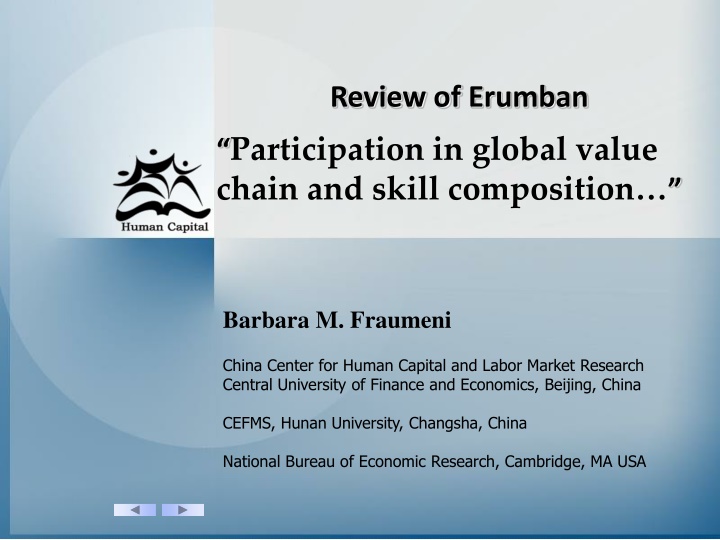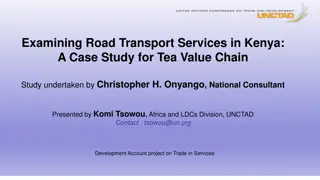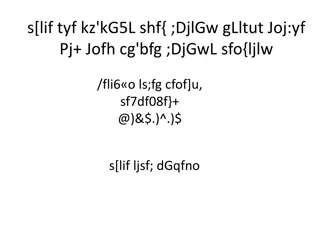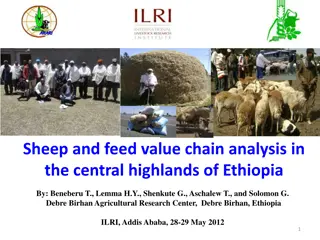Skill Composition Changes in Indian Industries due to Global Value Chain Participation
Global Value Chain, Skill Composition, Indian Industries, Labor Market, Economic Research
Download Presentation

Please find below an Image/Link to download the presentation.
The content on the website is provided AS IS for your information and personal use only. It may not be sold, licensed, or shared on other websites without obtaining consent from the author.If you encounter any issues during the download, it is possible that the publisher has removed the file from their server.
You are allowed to download the files provided on this website for personal or commercial use, subject to the condition that they are used lawfully. All files are the property of their respective owners.
The content on the website is provided AS IS for your information and personal use only. It may not be sold, licensed, or shared on other websites without obtaining consent from the author.
E N D
Presentation Transcript
Review of Erumban Participation in global value chain and skill composition Barbara M. Fraumeni China Center for Human Capital and Labor Market Research Central University of Finance and Economics, Beijing, China CEFMS, Hunan University, Changsha, China National Bureau of Economic Research, Cambridge, MA USA
Impact of participating in the global value chain in terms of backward and forward GVC participation on the changes in the skill composition of workers in Indian industries, 1995-2018 2
Focus Angle From the perspective of India, a developing country India is unusual in that 40% of its 2023 exports are service exports Was only 20% in the mid-1990 s Unusual for an emerging country such as China as well as for the U.S., Japan, & Korea Estimate employment and wage share equations for 3 different skill categories of workers low, medium, and high-skilled, including backward and forward GVC participation measures 3
Backward vs. forward GVC participation Backward: a country is using outputs, including goods, parts, resources, and services, provided by countries in prior segments of the value chain in production of exports Forward: the export outputs of a country are used by anothercountry 4
KLEMS +Data 25 industries (not construction or public administration) K stock for machinery, construction, & transport equipment KLEMS+ LF surveys for employment & compensation distribution Missing years interpolated LF survey benchmarks 5
TiVA Data & TFP TiVA Backward participation: foreign value added content in gross exports as % of gross exports Forward participation: domestic value added content in gross exports as % of gross exports Aggregate TFP as a weighted average of sectoral TFP (excluding the own sector) with value added weights 6
Estimation Methodology ? ??,?,?= ??+ ?=? ??,?. ????,?+ ??,? ???,?+ ??,? ???,?+ ??,? ?????? ??,?. ????,?,?+ ??,?. ????,?+ ? ?+ ??,?+ ??,?,? ??,?,? = share of worker type i in total employment or total compensation ??,?,?=wage rate of worker type j ??,? & ??,?= real output and capital stock ???,?& ???,?= backward and forward GVC participation rate ???? ??,?& ??,?,?=industry fixed effect and random error term Subscripts i, j, k, and t are respectively skill type (i), worker type (j), industry (k) and year (t) ? ?= aggregate TFP (except own sector) 7
Estimation Methodology Equation was estimated with 2 variations, using: cost shares or employment shares 5 different education skill groups: below primary, primary, middle, secondary, higher and above Fixed effects panel data regression 8
Results from employment share equation Decrease in the employment share of high and low-skilled workers when their wage rates increase High-skilled wage increases tend to be positively associated with positive changes in the employment share of low-skilled workers Substitution between high and low skilled workers is surprising, but there are L market imperfections 10
Results from employment share equation Positive impact of increasing low-skilled wage growth on medium skilled employment share Negative impact of increasing high-skilled wage growth on medium-skilled employment share Strong and positive impact of the medium-skilled wage rise on high-skilled employment share Medium-skilled jobs are more susceptible to capital intensification, indicating a potential substitution between medium-skilled workers and capital 11
Results from compensation share equation Own wage increases have a positive impact on all three worker categories compensation share, with the highest effect on high-skilled workers and the lowest on medium-skilled workers. However, wage increases in other skill categories have a significant negative impact on changes in the employment share of all three worker categories High-skilled wage increases have a negative effect on low and medium skilled compensation shares Both medium and low-skilled wage increases have a significant negative impact on high-skilled compensation shares, with low-skilled wage increases having a larger effect. 12
Results from compensation share equation Capital growth does not seem to have an impact on any of the 3 worker compensation categories, while output growth has a small negative (positive) effect on changes in the compensation share of medium (high)-skilled compensation shares. 13
GVC impact on skill composition* GVC/skill Low Medium High BACKWARD Emp share - - + Comp share FORWARD Emp share + - Comp share *All other results are not significant. 14
Net effect of GVC on workers Low-skilled No significant results that GVC harms low- skilled workers Forward GVC shown to benefit their employment share Medium-skilled Backward GVC harms medium skilled workers High-skilled For employment share, depends if it is backward (+) or forward (-) 15
Changes in skill distribution & total employment 70 450 400 60 350 50 300 40 250 200 30 150 20 100 10 50 0 0 1993-4 2004-5 2011-12 2018-9 < Primary Primary Middle Secondary >Secondary Employment (Mills.) 16
Comments? Acknowledged a preliminary paper Rise of online shopping and remote customer service What type of jobs are in the services export component? Explaining the results as a whole story Gender and employment trends background 18
Population aged 0-4 times EYS by gender 7.5 7.0 6.5 6.0 5.5 5.0 4.5 4.0 3.5 1995 2005 2010 2015 2019 Blue=Males, Yellow=Females 19
Youth employment and unemployment rates by gender 0.7 0.12 0.6 0.10 0.5 0.08 0.4 0.06 0.3 0.04 0.2 0.02 0.1 0.0 0.00 1999 1995 1998 2000 2001 2010 2011 1996 1997 2009 2002 2003 2004 2012 2015 2016 2005 2006 2007 2008 2013 2014 2017 2018 Blue=Males; Yellow=females Solid lines: Employment rate as a % of ages 15-24 Dotted lines: Unemployment rate as a % of ages 15-24 Left Y-axis: employment; Right Y-axis unemployment 20
Looking forward to seeing a more complete and refined paper in the future 21























